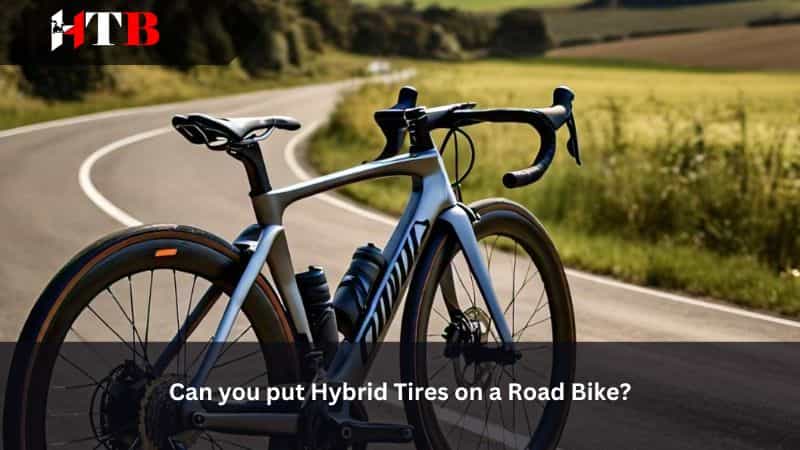Can you put Hybrid Tires on a Road Bike?
Imagine this: you’re cruising down a smooth, winding road on your sleek road bike, the wind in your hair and the sun on your face. But suddenly, you hit a patch of gravel or uneven terrain that sends a jolt through your entire body. If only there were a way to enjoy the speed and agility of a road bike while also being able to handle different types of surfaces with ease. Enter hybrid tires – the versatile solution that blurs the lines between road bikes and mountain bikes.
But can you really put hybrid tires on a road bike? In this article, we will check the tire technology and explore whether this innovative combination is just what you need to take your cycling adventures to new heights.
Understanding hybrid tires and road bikes
Hybrid tires are a versatile option for cyclists seeking a balance between speed and durability on various terrains. These tires blend the smooth, narrow profile of road bike tires with the rugged tread patterns of mountain bike tires. The result is a tire that can handle both pavement and light off-road trails with ease, making them ideal for urban commuters or recreational riders looking to explore diverse routes.
Road bikes, known for their lightweight frames and narrow, high-pressure tires optimized for speed on smooth roads, may benefit from hybrid tires in certain situations. By swapping out traditional road bike tires for hybrid ones, cyclists can enjoy improved traction and comfort without compromising too much on speed. This versatility allows road bike enthusiasts to venture off the beaten path and tackle unpaved surfaces confidently while still maintaining a level of performance expected from their sleek machines.
Can you really put Hybrid Tires on a Road Bike?
While the idea of putting hybrid tires on a road bike may seem unconventional at first, it is actually a viable option that can offer some interesting benefits. Hybrid tires are known for their versatility and ability to handle various terrains, making them appealing for riders looking to mix up their cycling experience. By putting hybrid tires on a road bike, you can increase the bike’s capability to tackle different surfaces such as gravel paths or rough roads without sacrificing too much speed.
One key consideration when contemplating hybrid tires on a road bike is the trade-off between grip and rolling resistance. While hybrid tires provide better traction and stability off-road, they may not be as efficient on smooth pavement compared to traditional road bike tires. It’s important to weigh your priorities and riding style before making the switch to hybrid tires, as it ultimately depends on your preference for speed versus versatility. Overall, experimenting with hybrid tires on your road bike can open up new opportunities for exploration and adventure in your cycling pursuits.
Hybrid Tire Basics
Size Understanding
Bike tire size markings, like 700Cx35, indicate a tire’s diameter and width. The “700C” refers to the wheel diameter, while “35” measures the width in millimeters. Choosing the correct tire size is crucial for optimal performance. Hybrid tires come in various widths, typically between 28mm and 42mm. Wider tires provide more stability and comfort but may reduce speed.
Anatomy Explained
Hybrid tires blend features from road and off-road tires. They have a more robust casing than road bike tires, offering better puncture resistance. The tread is designed for versatility, providing grip on mixed surfaces. The bead area, where the tire meets the rim, ensures a snug fit and contributes to overall stability during rides.
Tread Types
Hybrid tires feature tread patterns that strike a balance between smooth-rolling of road tires and the grip of off-road designs. Tread influences both traction and rolling resistance; deeper treads offer better grip but can slow you down. For city commuting or light trail riding, choose a hybrid tire with moderate tread for diverse conditions.
Compatibility with road bike frames
When considering compatibility with road bike frames, it’s essential to look beyond the surface level and delve into the nuances of design and functionality. Road bike frames are typically built for speed, agility, and aerodynamics, which may not always align perfectly with hybrid tires designed for a balance of comfort and performance.
The difference in tire size clearance between road bikes and hybrids can be a crucial factor to consider when contemplating whether hybrid tires are compatible with your road bike frame.
Additionally, the geometry of road bike frames plays a significant role in determining how well they can accommodate different types of tires. While some road bikes have more flexibility in terms of tire clearance due to their design features, others may be more restrictive.
Understanding the specific dimensions and limitations of your road bike frame will help you make an informed decision about whether fitting hybrid tires is feasible without compromising performance or safety on the roads. It’s worth noting that consulting with a professional bike mechanic or manufacturer is advisable before making any significant modifications to ensure compatibility with your road bike frame.
Advantages of using hybrid tires in road bikes
Hybrid tires offer a unique blend of features that make them ideal for road bikes in various conditions. The main advantage lies in their versatility, allowing riders to confidently navigate different terrains without needing to switch out tires. These tires strike a balance between smooth, fast-rolling capabilities on pavement and enhanced grip and durability for off-road adventures.
Moreover, hybrid tires provide a comfortable ride experience by absorbing vibrations and shocks from uneven surfaces, promoting better handling and control. This translates to increased stability and confidence for cyclists tackling mixed terrain or uncertain weather conditions. Overall, the adaptability and performance benefits of hybrid tires make them a compelling choice for road bike enthusiasts looking to expand their horizons and explore diverse riding experiences.
Choosing Hybrid Tires
Size Selection
Selecting the right tire size is crucial for optimal performance and comfort. Hybrid bikes can accommodate a range of sizes, but it’s important to match tire dimensions with rider needs and bike specs. Going too wide may affect the bike’s handling and increase drag, while too narrow tires might offer less cushioning on rough surfaces. Always check the frame and fork clearance to avoid compatibility issues when changing tire sizes.
Tread Importance
The tread of hybrid tires plays a significant role in safety and performance. Different patterns cater to various terrains, influencing grip and bike handling. For city commuting, look for treads that balance smooth rolling with enough pattern to manage wet streets. When riding on mixed surfaces, opt for more pronounced treads that can handle loose gravel or dirt paths.
Puncture Protection
Hybrid tires often incorporate special technologies like reinforced sidewalls or kevlar layers for puncture protection. They tend to be more resistant to punctures than traditional road tires due to these features. To minimize risks, regularly inspect your tires for debris and maintain proper inflation levels.
Hybrid Tire Sizes
Standard Sizes
Hybrid bikes blend the features of road and mountain bikes, with tire sizes to match. 700c tires are a standard; they roll efficiently on pavement while offering stability off-road. This size has roots in the French measurement system and remains popular for its versatility. Other common sizes include 26-inch and 29-inch, catering to different riding styles.
The 700c standard evolved over time, becoming the go-to for many cyclists. It’s known for good speed and comfort on varied surfaces. Understanding tire sizing is crucial. It includes two numbers: the diameter in millimeters (700) and the width (c). This international system simplifies finding replacements worldwide.
Measuring Tips
For a perfect hybrid tire fit, accurate measurement is key. One needs a tape measure or caliper to gauge the wheel rim to the outer edge—this determines the diameter. Then, measure across the widest part of the tire for width.
Tools like calipers ensure precision when measuring tire dimensions. They help avoid errors that could lead to poor fit or performance issues. If measurements seem off, double-check that the tire is fully inflated and measure again. Misreading can lead to incorrect purchases or unsafe riding conditions.
Frequently Asked Questions
Can hybrid tires be used on a road bike?
Yes, hybrid tires can be used on a road bike, but it may affect the speed and performance of the bike.
Will using hybrid tires on a road bike improve its durability?
Hybrid tires may offer improved durability compared to standard road bike tires, but it depends on the specific tire model.
Are hybrid tires suitable for long-distance cycling on a road bike?
Hybrid tires can be suitable for long-distance cycling on a road bike as they provide better traction and comfort.
Do hybrid tires require any special modifications to be installed on a road bike?
In most cases, hybrid tires can be easily installed on a road bike without the need for any special modifications.
Can hybrid tires handle rough terrain when used on a road bike?
While hybrid tires are more versatile than traditional road bike tires, they may not perform as well on extremely rough terrain.
What maintenance is required for hybrid tires on a road bike?
Regularly inspect for wear, keep them clean, and maintain recommended tire pressure for optimal performance and longevity.
How does puncture protection technology in hybrid tires work?
Puncture protection tech utilizes reinforced layers or sealant within the tire to prevent or quickly repair punctures while riding.
What should be the ideal tire pressure for hybrid tires on a road bike?
Follow the manufacturer’s guidelines, which typically range between 50-70 psi for hybrid tires, adjusting based on rider weight and conditions.
Conclusion
When it comes to deciding whether to put hybrid tires on a road bike, the key is to make an informed decision that fits your specific needs and riding style. Consider factors such as the terrain you typically ride on, your desired level of speed and comfort, and how much versatility you require from your bike. Hybrid tires can offer a compromise between the efficiency of road tires and the durability of off-road tires, providing a balanced option for riders who want to explore various types of terrain.
Ultimately, choosing hybrid tires for your road bike can open up new possibilities for your cycling adventures by allowing you to confidently tackle different surfaces with ease. However, it’s important to remember that tire choice is just one aspect of optimizing your bike’s performance. Regular maintenance and proper care are crucial in ensuring that your bike performs at its best no matter where you choose to ride. By making informed decisions about upgrades like tire choices, you can enhance your cycling experience and enjoy every journey on two wheels more fully.
Read More:
- Guide to Hybrid Bike Tire Pressure: Optimal PSI for Your Ride
- Hybrid vs Mountain Bike: Know the Differences
- Best Hybrid Bike Under 300: Top 10 Reviews
- Best Hybrid Bikes Under $400







